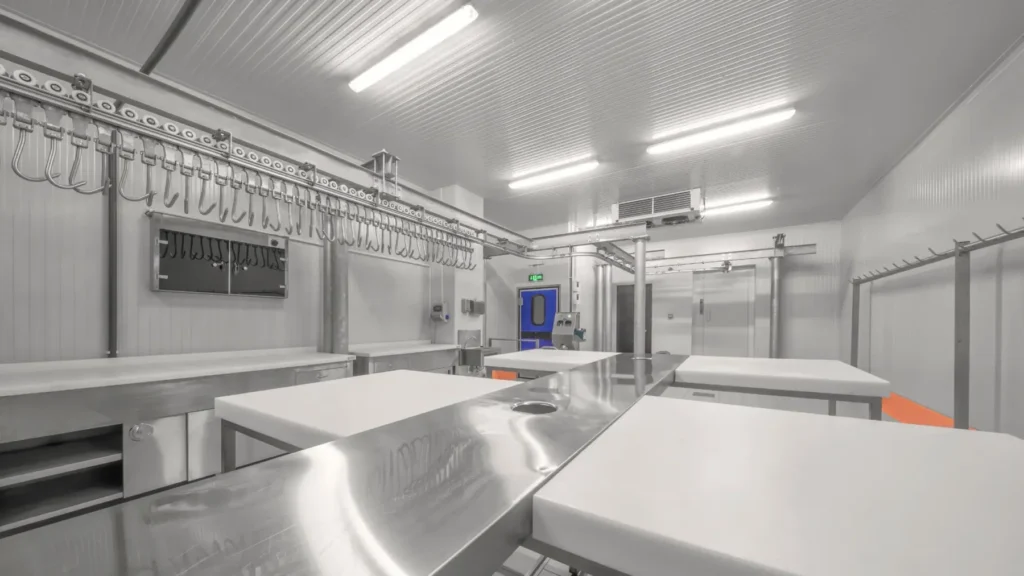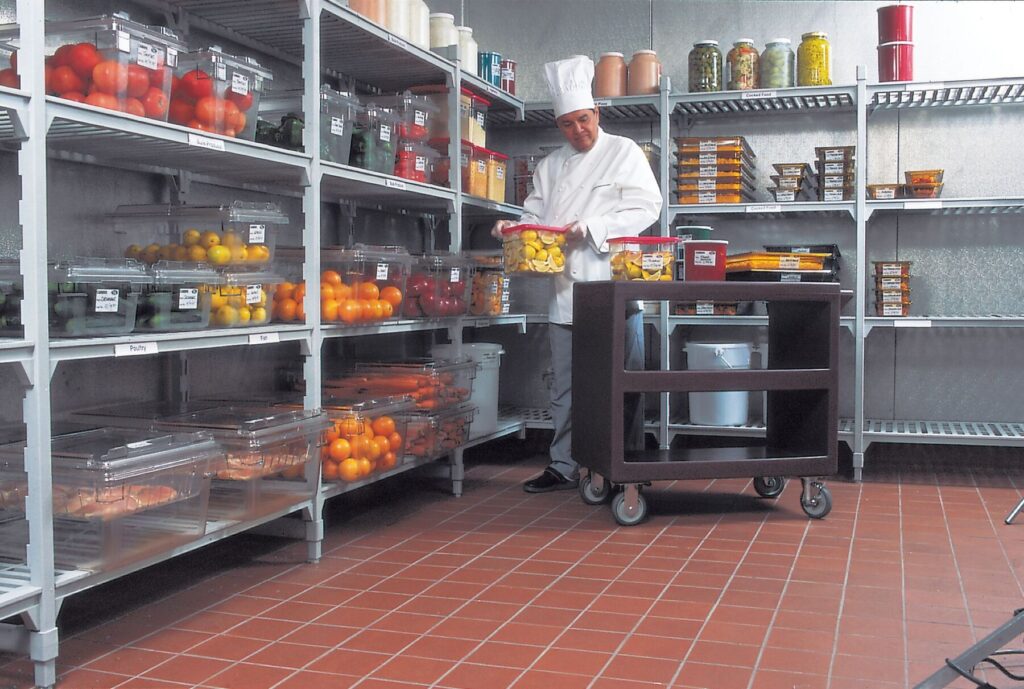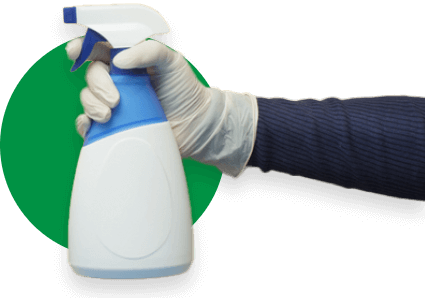In any commercial kitchen, cleanliness is a major emphasis. Clean surfaces and organization are simply easier to work with when tasked with preparing high volumes of food. Keeping things clean also means a lower risk of contamination of your food and equipment. And, of course, it’s simply a good sign to have a spotless commercial kitchen. A clean kitchen looks better and inspires confidence.
This goes for every area of the kitchen, not just the food prep areas. Floors, refrigerators, and shelves, for instance, all need to be cleaned as well. One of the easiest spaces to overlook in a commercial kitchen is the walk-in freezer floor. It’s not always obvious that a freezer floor needs cleaning, nor is it easy to find time to clean it. But leaving the freezer uncleaned for extended periods can lead to mold growth and unpleasant odors.
To help prevent this from happening, follow this simple step-by-step guide on how to clean a commercial freezer floor.
How Often Should You Clean Your Commercial Walk-In Freezer
Exactly how often you clean your walk-in freezer depends on its usage. However, the safest recommendation is to clean it on a monthly basis. Consistent, regular cleanings and inspections prevent larger problems, like mold or mildew buildup or thermostat malfunctions.
When performing your routine freezer cleaning, you should not just clean the floors. This time should also be used organizing your shelves, checking thermostats and sensors, and simply making sure everything in the freezer is in order.
You should perform a deep clean of the freezer and its internal components at least once per year.

Preparing for The Cleaning Process
There are only a few steps to follow when preparing to clean your walk-in freezer. First, remove any large debris or items from the floor. This includes dirt and fallen produce, but also any movable storage containers that are blocking the area you are cleaning. If you need to remove any food products from the freezer for extended periods, you should have a backup means of keeping them frozen.
Next, make sure all food in the freezer is covered. When cleaning the floor, there is minimal risk of chemical contamination. However, there is still some risk for products closer to the floor. If you’re doing a more thorough cleaning of other components, there is a greater risk. As such, it’s always best to be in the habit of making sure that all food is covered before cleaning.
Last, you’ll want to assemble the materials and equipment you’ll need. For cleaning a freezer floor, you will need a broom, mop and mop bucket, and freezer cleaner solution. If you are cleaning the freezer during operation hours, you might also put up wet floor signs after cleaning.
Step-By-Step Guide for Cleaning the Floor of Your Commercial Freezer
Once all the prep work is done, it’s time to start cleaning your freezer floor. The time frame for cleaning a walk-in freezer floor will vary depending on the size. But the steps are relatively straightforward as long as you have the right equipment.
Step 1. Remove Large Debris
Start by removing any large debris from the floor. There is often some build-up of dirt, discarded packaging, or fallen produce on the floor. All of this can be swept up with a broom prior to mopping or scrubbing the floors. Be as thorough as you can, especially taking time to sweep underneath counters and surfaces.
You might also use a stiff bristle brush on some spots to loosen up dirt or other tough stains on the freezer floor.
Step 2. Mop Floor With Freezer Clean Product
Once the floor is free from large debris, it’s time to scrub it. Use a specialized freezer-clean chemical product like Ecolab Kool Klene when mopping or scrubbing your floors. These chemical products are specially formulated to remove difficult stains without freezing afterward. Standard cleaning chemicals typically have a higher freezing temperature than specialized freezer cleaning products. This can cause ice to build up on surfaces, which will require deeper cleaning later on. Ice buildup on the freezer floor is especially dangerous because it can cause workers to slip and injure themselves.
With that said, you may still wish to wipe up the floor with a dry mop after scrubbing. This is done simply to avoid a wet, slippery freezer floor during your kitchen’s operating hours. You might also consider putting up wet floor signs in the walk-in freezer (depending on its size) as a safety precaution.
Larger freezers may use an auto-scrubber instead of a mop and bucket for floor cleaning.
Step 3. Replace Any Products You Removed Prior to Cleaning
Once the floor has been scrubbed, the cleaning is done. All that’s left to do is to replace anything you removed before cleaning. Return everything to where you found it, or use this opportunity to reorganize and de-clutter the freezer.

Tips for Maintaining a Clean Freezer Floor
Cleaning a commercial freezer floor is one thing. Keeping the freezer clean over a long period of time is a different challenge. Here are a few simple tips you can follow to maintain a clean freezer at all times.
Keep the Doors Closed
This may sound obvious, but you need to keep the cold air sealed in your freezer. Commercial freezer doors are specially built for insulation. This means that leaving the door open, even just a crack, can cause cold air to leak out, or warm air to drift in. This can cause mold growth and ice accumulation, neither of which are desirable.
Clean Floors Outside the Freezer
If you don’t want people tracking dirt and grime into your freezer, you should consistently clean the floors outside, too. Most commercial kitchen floor surfaces can be cleaned using standard floor cleaners, a mop, and a broom.
Monitor Freezer Temperature
Keep an eye on your freezer temperatures daily to make sure they don’t get too high or too low. As mentioned above, temperature fluctuations can cause a variety of serious problems in a walk-in freezer. The simplest way to avoid this is to monitor temperatures daily. Fix any problems immediately if the temperature is too high or too low. For extra caution, you might have an electrician periodically inspect your freezer’s wiring as well.
Turn off Lights When Not In Use
Freezer lights emit a small amount of heat. This may not seem significant, but it can be if you leave the lights on for too long. Not only is this good for the overall cleanliness of your freezer, but turning the lights off also reduces the electric bill.
Check and Clean Condenser Coils, Fans, Vents, Etc.
Lastly, there are a lot of freezer components that need cleaning besides the floor. Commercial freezers have an evaporator coil, condenser coils, and fans. All of these need regular cleanings as well, as do the freezer walls. You can use a stiff bristle brush and freezer cleaner products to remove most debris and buildup on these components. Once again, make sure that all food is covered before using any cleaning chemicals in the freezer.

FAQs About Cleaning Commercial Freezer Floors
How often should a commercial freezer be cleaned?
Most commercial freezers should be cleaned at least once per month. This includes inspecting equipment, as well as cleaning floors and other surfaces. Additionally, mechanical components, like fans and evaporator coils, should be deep cleaned at least once per year.
How do you clean a freezer floor without turning it off?
A walk-in freezer can be cleaned without being turned off by using specialized freezer cleaning products. Freezer cleaners are designed to withstand freezing temperatures, so they will evaporate rather than flash-freeze after cleaning.
How do you clean a commercial walk-in fridge?
A commercial walk-in fridge or cooler can be cleaned using standard cleaning products as long as proper food safety practices are observed.
Can I use a regular household cleaning product to clean my commercial freezer floor?
Commercial freezer floors should be cleaned with specialized cleaning products to prevent excessive ice buildup or chemical contamination.
Need Help Keeping Your Commercial Kitchen Clean?
Keeping a commercial kitchen clean is no small task, especially during operating hours. When a kitchen gets busy, nobody has time to stop and clean everything. For a deep cleaning of a commercial kitchen, it’s often easiest to turn to professional cleaning services.
For businesses in any industry in the Dallas-Fort Worth metroplex, Dallas Janitorial Services can be trusted to handle your cleaning. Want to hire our cleaning team or learn more about the value of professional cleaning services? Feel free to contact us today to learn more or get a free quote.


